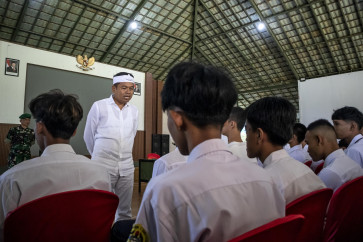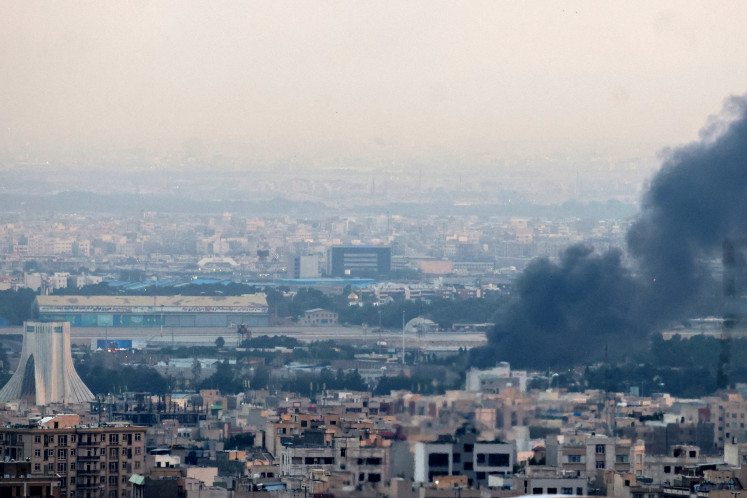Popular Reads
Top Results
Can't find what you're looking for?
View all search resultsPopular Reads
Top Results
Can't find what you're looking for?
View all search resultsSchool buildings close to collapse as repair funds slow to arrive
Bad condition: HM Soleh, the deputy headmaster of state junior high school SMP 273 at Kampung Bali in Tanah Abang, Central Jakarta, observes debris from the roof and broken furniture in one of the school's damaged classrooms
Change text size
Gift Premium Articles
to Anyone

B
span class="caption" style="width: 212px;">Bad condition: HM Soleh, the deputy headmaster of state junior high school SMP 273 at Kampung Bali in Tanah Abang, Central Jakarta, observes debris from the roof and broken furniture in one of the school's damaged classrooms. (JP/Elly Burhaini Faizal)It was a bright sunny day when HM Soleh, a social studies teacher, inspected several classrooms to see if everything was OK. The classes were empty as the students were on a meal break. Just as he was preparing to call the students back to class, he heard a loud cracking sound from the roof.
Seconds later, the roof of two classes collapsed. First the ceiling fell in, then the roof came crashing down.
“I couldn’t do anything but flee. The roof of the two classes were in tatters as if destroyed by a massive earthquake,” said Soleh when visited by The Jakarta Post on Tuesday.
One-and-a-half years later, roof collapses remain the biggest fear for the school’s teachers and students, since no promise of repairs by the government has translated into reality.
Soleh said that he felt a sense of dread every time he recalled the terrifying roof collapse in February 2010 at SMP Negeri 273 state junior high school in Kampung Bali, Tanah Abang, Central Jakarta.
“We are very uneasy, and beginning to feel that someone might have been buried under the debris,” said Soleh, who is also the school’s deputy headmaster.
Neither students nor teachers sustained serious injuries when the roof of their classrooms collapsed. Unfortunately, it was not the only time the school experienced a roof collapse. In total, the roofs of seven classrooms, including one electronics lab, collapsed during 2010-2011.
The last incident occurred when the roof of two classes and the electronics lab suddenly collapsed in May 2011. It happened only three months after Jakarta Deputy Governor Prijanto paid a visit to the school and promised building improvements.
“Thank God, no students were injured since the incident happened during school holidays,” said Soleh.
The fear of roof damage then led the school management to abandon four classrooms due to their bad condition. A library on the second floor is still in use despite its poor condition.
“On each cloudy day, we instruct students to leave the library because we worry that heavy rains will fall and cause the roof to collapse.”
SMPN 273, which was formerly a Chinese school, was built in 1952. Shortly after the failed coup attempt in 1965, the government took over the building to use as Sekolah Teknik Negeri 2 state vocational school. The building has had no infrastructural improvements made to it since its first use as SMPN 273 in 1995.
During his visit in February this year, Prijanto asserted that even though SMPN 273’s walls were still thick and relatively strong it must soon be repaired. However, a recent announcement by the Jakarta administration’s Education Department revealed that SMPN 273 was not included in this year’s School Rehabilitation and Reconstruction Project.
“This is the umpteenth time that we’ve had unfulfilled promises from the government,” said Was’ad, the school’s administration head. He said the long-delayed repair of unsafe roofs should be done as quickly as possible to ensure the students’ safety.
SMPN 273 was one of the heavily damaged schools in Jakarta recently visited by Prijanto, along with SDN Malaka Jaya 06 and SDN Pondok Bambu 14 state elementary schools and SMPN 198 state junior high school in Duren Sawit.
According to Was’ad, no clear explanations have been given as to why the local government continues to fail to meet its promises.
Deputy Education Minister Fasli Jalal said the government had handed over the 2011 special allocation fund (DAK) of Rp 10 trillion (US$1.13 billion) to local governments.
“We allocate the [DAK] fund for rehabilitation and reconstruction projects of both elementary and junior high schools. We have handed this domain over to local governments,” he said, adding that the funds could also be used to improve education facilities and equipment, such as skill improvements, books and laboratories.
According to Education Ministry data, 182,500 or 20.3 percent of the total 899,016 classrooms in state and private elementary schools have moderate damage, while 110,598 or 12.3 percent of the total classrooms are heavily damaged.
Fasli said any infrastructural improvements should be quickly made, since 103,757 or 93.81 percent of heavily damaged classrooms were in state elementary schools, most of the students of which come from low-income families.
“We should be ready to quickly repair classrooms with just moderate damage because they could fall into the ‘heavily damaged category’ at any time,” he added.
Giving a similar picture of school buildings in poor condition, ministry data further reveal that many junior high students found learning activities less than comfortable because 82,892 or 27.79 percent of total 298,268 classrooms suffered from moderate damage while 42,428 or 14.23 percent of the classrooms were seriously damaged.
However, Fasli said, many commitments often had poor implementation.
“We often find local authorities prioritize infrastructural improvements in schools that are in quite good condition,” he said. However, the central government has agreed to transfer the DAK fund to the local budget, making it susceptible to political maneuvering.









